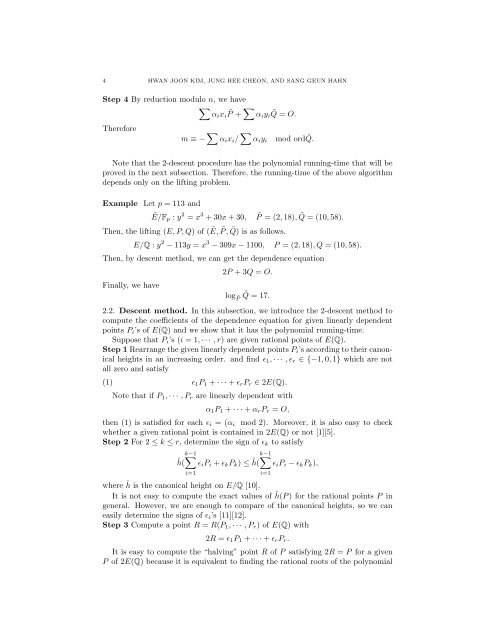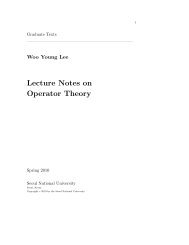ON REMARKS OF LIFTING PROBLEMS FOR ELLIPTIC CURVES 1 ...
ON REMARKS OF LIFTING PROBLEMS FOR ELLIPTIC CURVES 1 ...
ON REMARKS OF LIFTING PROBLEMS FOR ELLIPTIC CURVES 1 ...
You also want an ePaper? Increase the reach of your titles
YUMPU automatically turns print PDFs into web optimized ePapers that Google loves.
4 HWAN JO<strong>ON</strong> KIM, JUNG HEE CHE<strong>ON</strong>, AND SANG GEUN HAHN<br />
Step 4 By reduction modulo n, we have<br />
∑<br />
αi x i ˜P +<br />
∑<br />
αi y i ˜Q = O.<br />
Therefore<br />
m ≡ − ∑ α i x i / ∑ α i y i<br />
mod ord ˜Q.<br />
Note that the 2-descent procedure has the polynomial running-time that will be<br />
proved in the next subsection. Therefore, the running-time of the above algorithm<br />
depends only on the lifting problem.<br />
Example Let p = 113 and<br />
Ẽ/F p : y 2 = x 3 + 30x + 30, ˜P = (2, 18), ˜Q = (10, 58).<br />
Then, the lifting (E, P, Q) of (Ẽ, ˜P , ˜Q) is as follows.<br />
E/Q : y 2 − 113y = x 3 − 309x − 1100, P = (2, 18), Q = (10, 58).<br />
Then, by descent method, we can get the dependence equation<br />
Finally, we have<br />
2P + 3Q = O.<br />
log ˜P ˜Q = 17.<br />
2.2. Descent method. In this subsection, we introduce the 2-descent method to<br />
compute the coefficients of the dependence equation for given linearly dependent<br />
points P i ’s of E(Q) and we show that it has the polynomial running-time.<br />
Suppose that P i ’s (i = 1, · · · , r) are given rational points of E(Q).<br />
Step 1 Rearrange the given linearly dependent points P i ’s according to their canonical<br />
heights in an increasing order. and find ɛ 1 , · · · , ɛ r ∈ {−1, 0, 1} which are not<br />
all zero and satisfy<br />
(1)<br />
ɛ 1 P 1 + · · · + ɛ r P r ∈ 2E(Q).<br />
Note that if P 1 , · · · , P r are linearly dependent with<br />
α 1 P 1 + · · · + α r P r = O,<br />
then (1) is satisfied for each ɛ i = (α i mod 2). Moreover, it is also easy to check<br />
whether a given rational point is contained in 2E(Q) or not [1][5].<br />
Step 2 For 2 ≤ k ≤ r, determine the sign of ɛ k to satisfy<br />
k−1<br />
∑<br />
k−1<br />
ĥ( ɛ i P i + ɛ k P k ) ≤ ĥ( ∑<br />
ɛ i P i − ɛ k P k ),<br />
i=1<br />
where ĥ is the canonical height on E/Q [10].<br />
It is not easy to compute the exact values of ĥ(P ) for the rational points P in<br />
general. However, we are enough to compare of the canonical heights, so we can<br />
easily determine the signs of ɛ i ’s [11][12].<br />
Step 3 Compute a point R = R(P 1 , · · · , P r ) of E(Q) with<br />
i=1<br />
2R = ɛ 1 P 1 + · · · + ɛ r P r .<br />
It is easy to compute the “halving” point R of P satisfying 2R = P for a given<br />
P of 2E(Q) because it is equivalent to finding the rational roots of the polynomial













